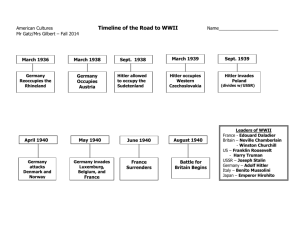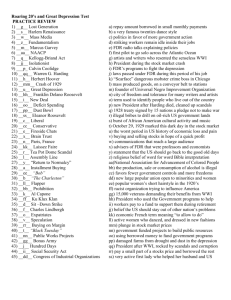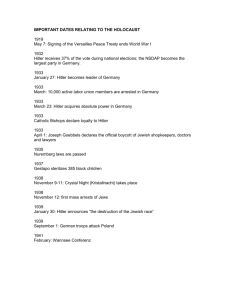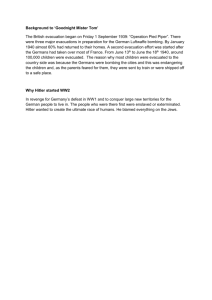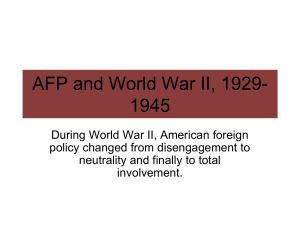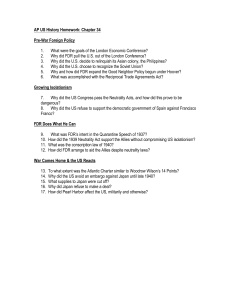1) Ernest Hemingway penned the phrase “The Lost Generation” to
advertisement
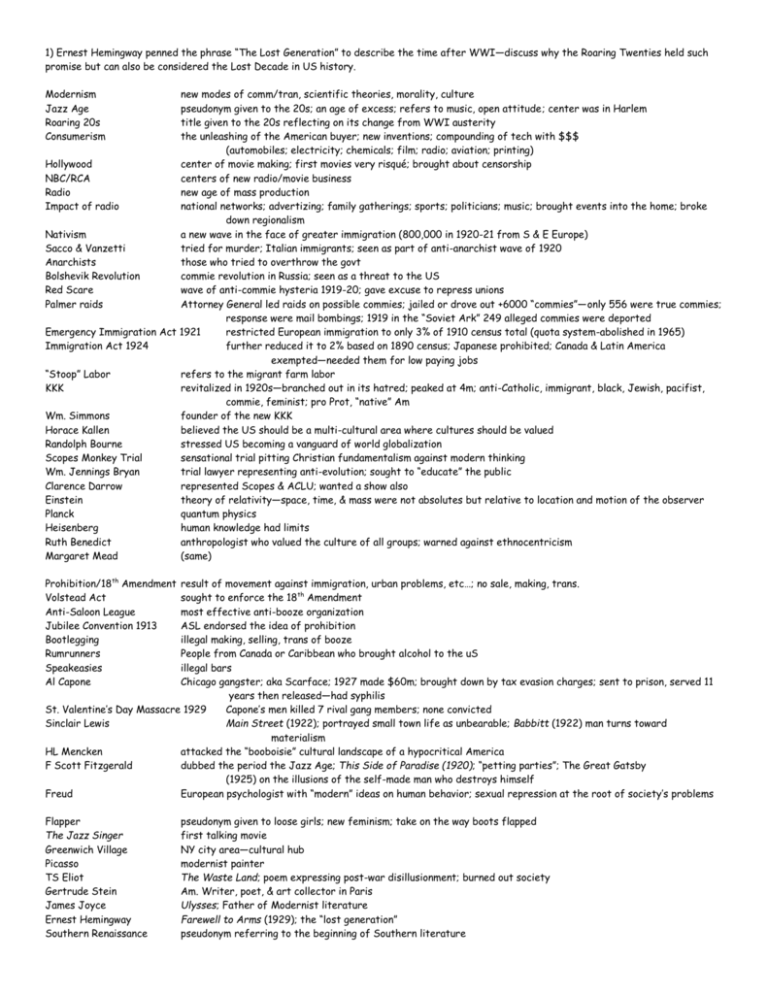
1) Ernest Hemingway penned the phrase “The Lost Generation” to describe the time after WWI—discuss why the Roaring Twenties held such promise but can also be considered the Lost Decade in US history. Modernism Jazz Age Roaring 20s Consumerism new modes of comm/tran, scientific theories, morality, culture pseudonym given to the 20s; an age of excess; refers to music, open attitude ; center was in Harlem title given to the 20s reflecting on its change from WWI austerity the unleashing of the American buyer; new inventions; compounding of tech with $$$ (automobiles; electricity; chemicals; film; radio; aviation; printing) Hollywood center of movie making; first movies very risqué; brought about censorship NBC/RCA centers of new radio/movie business Radio new age of mass production Impact of radio national networks; advertizing; family gatherings; sports; politicians; music; brought events into the home; broke down regionalism Nativism a new wave in the face of greater immigration (800,000 in 1920-21 from S & E Europe) Sacco & Vanzetti tried for murder; Italian immigrants; seen as part of anti-anarchist wave of 1920 Anarchists those who tried to overthrow the govt Bolshevik Revolution commie revolution in Russia; seen as a threat to the US Red Scare wave of anti-commie hysteria 1919-20; gave excuse to repress unions Palmer raids Attorney General led raids on possible commies; jailed or drove out +6000 “commies”— only 556 were true commies; response were mail bombings; 1919 in the “Soviet Ark” 249 alleged commies were deported Emergency Immigration Act 1921 restricted European immigration to only 3% of 1910 census total (quota system-abolished in 1965) Immigration Act 1924 further reduced it to 2% based on 1890 census; Japanese prohibited; Canada & Latin America exempted—needed them for low paying jobs “Stoop” Labor refers to the migrant farm labor KKK revitalized in 1920s—branched out in its hatred; peaked at 4m; anti-Catholic, immigrant, black, Jewish, pacifist, commie, feminist; pro Prot, “native” Am Wm. Simmons founder of the new KKK Horace Kallen believed the US should be a multi-cultural area where cultures should be valued Randolph Bourne stressed US becoming a vanguard of world globalization Scopes Monkey Trial sensational trial pitting Christian fundamentalism against modern thinking Wm. Jennings Bryan trial lawyer representing anti-evolution; sought to “educate” the public Clarence Darrow represented Scopes & ACLU; wanted a show also Einstein theory of relativity—space, time, & mass were not absolutes but relative to location and motion of the observer Planck quantum physics Heisenberg human knowledge had limits Ruth Benedict anthropologist who valued the culture of all groups; warned against ethnocentricism Margaret Mead (same) Prohibition/18th Amendment Volstead Act Anti-Saloon League Jubilee Convention 1913 Bootlegging Rumrunners Speakeasies Al Capone result of movement against immigration, urban problems, etc…; no sale, making, trans. sought to enforce the 18th Amendment most effective anti-booze organization ASL endorsed the idea of prohibition illegal making, selling, trans of booze People from Canada or Caribbean who brought alcohol to the uS illegal bars Chicago gangster; aka Scarface; 1927 made $60m; brought down by tax evasion charges; sent to prison, served 11 years then released—had syphilis St. Valentine’s Day Massacre 1929 Capone’s men killed 7 rival gang members; none convicted Sinclair Lewis Main Street (1922); portrayed small town life as unbearable; Babbitt (1922) man turns toward materialism HL Mencken attacked the “booboisie” cultural landscape of a hypocritical America F Scott Fitzgerald dubbed the period the Jazz Age; This Side of Paradise (1920); “petting parties”; The Great Gatsby (1925) on the illusions of the self-made man who destroys himself Freud European psychologist with “modern” ideas on human behavior; sexual repression at the root of society’s problems Flapper The Jazz Singer Greenwich Village Picasso TS Eliot Gertrude Stein James Joyce Ernest Hemingway Southern Renaissance pseudonym given to loose girls; new feminism; take on the way boots flapped first talking movie NY city area—cultural hub modernist painter The Waste Land; poem expressing post-war disillusionment; burned out society Am. Writer, poet, & art collector in Paris Ulysses; Father of Modernist literature Farewell to Arms (1929); the “lost generation” pseudonym referring to the beginning of Southern literature Thomas Wolfe Wm Faulkner Babe Ruth Jack Dempsey Charles Lindbergh Amelia Earhart Henry Ford Lincoln Highway Impact of automobile Look Homeward; SR writer The Sound & the Fury; SR writer baseball player; set home run record 714; primarily played with Yankees 1919-26 world heavyweight champion; first boxer to get 1 m flew across Atlantic in 33 hours; $25,000 prize; later a Nazi sympathizer tried to fly around the world perfected automobile manufacturing; Model T; by 1929 one auto for every 5 Americans started around 1910; linked the continent; over 3000 miles employment; supporting industries; RR decline; change diets; paved roads; tourism; women less dependent; leisure hours; less isolation; rise of suburbs 1920 Election returned to laissez faire Republicanism of the Gilded Age Isolationism US turned inward Five Power Naval Treaty limited the number of ships (U.S., Britain, Japan, France, and Italy) Kellogg-Briand Pact 1928 signed by 62 nations; outlawed war—provided a false sense of security Merchant Marine Act of 1920 allowed US merchant ships used in WWI to be sold or decommissioned Warren Harding opposed LoN; wanted low taxes, high tariffs, immigration restrictions, & aid to farmers; tended to be more Progressive Normalcy Charles Evan Hughes Andrew Mellon Herbert Hoover Wm Taft Ohio Gang name given to Harding’s tenure as president—return to conservative values Sec of State Sec of Treasurer; 3rd richest man in US behind Rockefeller & Ford Sec of Ag appointed Chief Justice Harding’s group of Ohioan cronies; brought scandal Bureau of the Budget General Accounting Office Fordney-McCumber Tariff Teapot Dome Scandal 1921; assist the president in preparing a budget to prevent excessive spending created to audit govt spending increased the tariff; overtime resulted in other nations doing the same naval oil reserves at Teapot Dome, Wyoming and Elk Hill, California; Sec of Interior found guilty of bribery & sentenced to one year in jail (first cabinet member ever sent to jail) Calvin Coolidge Election of 1924 Federal Communications Commission Kelly Act of 1925 Air Commerce Act of 1926 Veteran’s Bureau American Legion Agriculture Federal Farm Board Yellow Dog Contracts William Green Railway Labor Act of 1926 Gastonia Strike of 1929 Election of 1928 tended to be a laissez faire president deferring to Congress; took over after Harding died Coolidge won with Democrats in disarray est 1927 to regulate growing communication industry Federal govt began to subsidize aircraft industry through airmail contracts federal funds to aviation projects, such as airports created in 1921 to assist returning soldiers created in 1919 by Teddy Roosevelt Jr. weakest sector of the economy; mechanization & efficiency hurt small farmers 1929; created to stabilize process contracts that forced workers to stay out of unions leader of United Mine workers; less of a firebrand than Samuel Gompers established a mediation board to settle railroad worker disputes prolonged strike in textile mills that turned violent Hoover vs. Smith—Democrats offered very little different from Rep; Hoover won; wanted to stabilize agriculture & continue Prohibition Hawley Smoot Tariff of 1930 Speculation Bull/Bear Market Buy on the Margin Black Thursday Oct 29, 1929 “Black Tuesday” Hoovervilles Reconstruction Finance Corp Glass-Steagall Act 1932 Emergency Relief Act 1932 Muscle Shoals Bill Hoover Dam Norris-LaGuardia Anti-Injunction Act Bonus Marchers highest tariff in US history refers to the buying of stock hoping it would go up stock marker rise and fall to buy stock paying only a small amount and getting loaned the rest initial plunge of the market after reaching a peak of 381 points most devastating single day up to that time; within a few days the market lost almost half its value temporary slums of poor/unemployed; by 1932 12 million unemployed; GDP dropped almost 50% offered money to banks, insurance companies, etc… released $750 m in gold & offered more money gave money to the states for relief public works project in TN area for electricity 1930-36; hydroelectric dam outlawed anti-union contracts (1932) farmers & veterans who marched on Washington to get payment of veteran’s money; 20,000 converged; troops brought in to disperse 2) The US emerged from the 1930s drastically changed from what it was in 1930—discuss the challenges the US faced, the attempts to meet those challenges, & how FDR helped to define the overall character of the decade. FDR Pres. during Depression; elected in 1933; favored providing jobs over giving money; fireside chats +30; “Brain Trust”; 3 R’s incl Relief, Recovery, & Reform Fascism ultra-nationalism; was rising in Germany, Italy, & Japan Communism had solidified under Stalin in Russia New Deal name given to FDR’s approach to the Depression (Progressivism on steroids) Norman Thomas socialist candidate 20th Amendment pres would take office earlier (Jan 20th rather than March 4th) Economy Act granted the pres ability to slash pay & reorganize agencies to reduce spending Beer Wine Revenue Act permitted sale of beverages with 3.2% alcohol or less 21st Amendment overturned prohibition in 1933 100 Days March 9th – 16th June; Alphabet agencies; Congress mainly Democrats Civil Works Admin put people on govt payroll for 4 months (over 4 m) CCC Civilian Conservation Corps; planted over 200 m trees Gold abandoned the gold standard in 1933 Federal Emergency Relief Act headed by Henry Hopkins; expanded aid to unemployed Agri. Adjustment Act gave pres power to expand money supply; sought to pay farmers to reduce supply Henry Wallace Sec of Ag John Steinbeck Grapes of Wrath; told the story of displaced farmers (okies) heading west Dust Bowl/black blizzards Dry farming techniques Soil Conservation Act provided payments for conserving soil Emergency Farm Mortgage Act provided for refinancing farm loans TVA Act provided Federal funds for hydroelectricity in TN (2 in KY); inexpensive electricity Banking Act established FDIC Farm Credit Act reorganized Federal farm subsidies Works Progress Admin also headed by Hopkins; replaced FERA; provided public works projects Federal Writer’s Project under the WPA; provided jobs to writers Nat. Youth Admin provided part-time employment to the youth Public Works Admin $3.3 billion for buildings, infrastructure National Recovery Admin sought to set industrial wages & prices; provide jobs, workplace standards Mexican Americans Native Americans Indian reorganization Act ended the Dawes Act by restoring land to Natives African Americans Scottsboro Case 9 AA youths convicted of raping 2 white women (1931) Norris v Alabama S Ct ruled not allowing AA on juries denied due process Richard Wright Native Son (1940); told the story of a black man moved to actions beyond his control 2nd New Deal Wagner Act helped workers form unions & investigated actions of anti-unionism John Lewis head of the United Mines Workers; rebuilt the union Walter Reuther led auto workers on strike Social Security Act of 1935 pension to those over 65 Revenue Act raised tax rates on annual income over $50,000; was attacked by wealthy John Maynard Keynes economist whose ideas included priming the pump with govt spending (deficit spending) Eleanor took an activist approach to helping AA, women; distant relationship to FDR Frances Perkins first woman cabinet member; Sec of Labor Pearl Buck female novelist; The Good Earth (1931) American Liberty League opposed ND based on ind & property rights Huey Long the Kingfish; gov of LA; Share the Wealth program—confiscate wealth & redistribute assassinated in 1935 Francis Townsend wanted govt pensions for the elderly Father Coughlin called for the coinage of silver & made anti-Semitic attacks on bankers Election of 1936 FDR vs. Landon Court Packing Plan FDR saw a threat to his plans by the S Ct; sought to increase justices by 6 plan backfired in the short term; in the long term FDR replaced justices & the courts became more friendly to the ND Late 1930s by 1936 unemployment down 10% to 15%; increased the debt—resulted in recession Pros: Roosevelt did something pushed the idea that govt was tied to the welfare of the people total economic collapse was avoided resulted in a more equitable distribution of wealth preserved democracy citizens had the ability the regain self-confidence & self-respect Cons: Resulted in waste & employed those not suited for particular jobs Did things without studying options first Created a bureaucracy Raised the federal debt Increased the power of the federal govt over state govts Increased reliance of Am on welfare Too much govt interference in business Did not cure the Depression 3) The US emerged from WWI in no mood to be part of the world order— and the reluctant entrance into WWII. discuss the efforts to maintain isolation, how those efforts failed, From isolationism to involvement post-WWI isolationism w/ US not in LoN Debt repayment controversy two POV on debt (Europe vs US); tangled web of money transferring b/t European countries & the US; issue Johnson Debt Default Act (1934) no private loans to a country who had defaulted Disarmament Increasing tensions w/ Japan Five Power Treaty (1922) limited naval size (2 spheres—US, Brit, Japan) Four Power Treaty countries would respect other’s territories Nine Power Treaty agreement to maintain Open Door to China treaties provided false hope & not enforceable 1928 K-Briand Pact treaty that outlawed war Sen Gerald Nye conducted hearings from 1934-37 that blamed WWI on & the arms industry Neutrality Acts of 1935, 1936, and 1937 limited the ability to aid Allies in the face of war WWII: The Sequel Who’s Who: of tariffs bankers Axis Powers—Germany, Italy, Japan, Hungary, Romania, Bulgaria, Thailand Allied Powers—Britain, France, US, USSR, Canada, Australia, India Causes: Long-Range Causes: --Failure of the League of Nations --part of Wilson’s 14 points to peace; US did not join; opens a vacuum --Failure of inter-war isolationism and pacifism --Naval size was limited in 1921 --1928 the Kellogg-Briand Pact officially outlawed war to solve conflicts --Impact of world-wide Great Depression --Rise of ultra-nationalism (Fascism) in Italy, Germany, and Japan Fascism--generally people who wanted to restore the greatness of a previous time period by means of a strong authoritarian ruler; ie. ultra-nationalism exalting the nation over the & suppressing all opposition Italy: Benito Mussolini--started the fascist movement in Italy in 1922. --symbol of fascism came from a Roman bundle of sticks (fasci) representing the band of thugs --causes--WWI which left many former soldiers w//o jobs & a feeling of humiliation—as a result many banded together to form fighting units demanding action & using intimidation --“Black Shirts”--against socialists, labor movements, democracies, & Jews. --labor strikes, peasants seizing land, & worker occupation of factories; fear of commies --Mussolini appointed Prime Minister & appointed fascist members in the gov’t., crushed all opposing pol. parties, reduced unemployment, & used propaganda to influence the --negotiated the Lateran Treaty of 1929--established Vatican City --joined Hitler in the 1930s as part of the Axis powers & begin a period of expansion --invaded Ethiopia in 1935 to avenge a humiliating defeat in 1896 Germany: Bismarck—in 1870 united them under the one state of Prussia & then Germany --causes: internal turmoil from Red Guards (pro-commies)—post-WWI revolutionaries from Russia and Freikorps—paramilitary group wanting to overthrow the gov’t. --After the war, a wave of new inflation swept across the country wiping out the middle class—money became worthless & all savings were lost. individual tactics. people --rise of the National Socialist German Workers Party or Nazi party led by Hitler in 20s --Fueled by the desire to reverse the humiliating Versailles Treaty that was forced on Germany at the end of WWI w/ its harsh reparations, Hitler wanted Germany to regain its military glory & started a wave of new expansionism (militarism) --Beer Hall Putsch: 1923 revolt led by Hitler; imprisoned for nine months --Reichstag fire—Hitler became leader/chancellor in 1933 w/ the Enabling Act --Hitler promised to guide the state & incorporate all German speaking people --appealed to mid/upper class businessmen who feared communism & socialism. --Hitler had withdrawn from the League of Nations in 1933 --suspended reparation payments --introduced conscription --created an air force (the Luftwaffe) in 1935 led by Hermann Goring --tactics: fear & propaganda --Josef Goebbels—chief propagandist --Gestapo—secret police; created in 1936 to frighten & kill --Night of the Long Knives--1934 purge of the ranks of Hitler’s pol. enemies. --Article 48--Hitler suspended all civil liberties; arrested thousands; Nazi Party became the only legal party & purged the gov’t. & military. --Heinrich Himmler--leader of the SS; arrested thousands & spread a reign of terror --Nuremberg Rallies--ultra-nationalistic pro-Hitler “feasts” or rallies --Women were urged to return to the home & produce strong children (given medals) --Economic--Hitler also began a massive economic program that restored employment. --attacked modern art & promoted sports in the name of nationalism. --use Jews as a scapegoat: --Nuremberg Laws--excluded Jews from civil service in 1933, deprived them of citizenship & civil rights, prohibited intermarriage, made them wear special emblems, encouraged the boycott of Jewish businesses, & increasing sent them to concentration camps. --Kristallnacht (1938)--Jewish businesses & synagogues vandalized & massive round-ups of Jews began. Short Range Causes: --Spanish Civil War (1936)--king was deposed in 1931 & a weak gov’t. coalition broke down in ‘36 --General Francisco Franco—conservative leader; established a right-wing dictatorship until ’75 --both Germany & Italy sent men to fight for Franco & the USSR sent men to help the leftists. --US declared its neutrality; many volunteers fought against Franco (Abraham Lincoln Brigade) --In all 600,000 people died & in the end Franco. --Gradual takeover of areas: --Rhineland--between Germany & Fr.; Hitler sent troops in 1936; protested but did nothing --Austria (1938); demanded annexation; part of unification of German speaking peoples. --Sudentenland: in Czechoslovakia; a German minority was located; was annexed --Munich Conference—(1938) called to solve European crisis; Br. PM Neville Chamberlain-- gave Hitler what he wanted (the Sudentenland); “Appeasement”—policy of giving in to the bully hoping it satisfies him --Europe feared another war, the rise of communism, & lacked preparedness for war-gave in to Hitler --Czechoslovakia—invaded in 1939 --Poland—invaded in 1939 using his blitzkrieg tactics (airpower/tanks first then infantry) --Nazi-Soviet Non-Aggression Pact—to prevent a 2 front war & to split Poland w/ the Soviet Union --Br & Fr. declared war on Germany --the Soviet Union invaded Finland, eastern Poland, Lithuania, Estonia, & Latvia. Phony War (Oct 1939-Apr 1940) period b/t fall of Poland & Germany’s next move; general disbelief in what was happening Fall of Finland USSR invaded Invasion of Denmark and Norway (Apr 1940) Denmark falls in one day to Germany Invasion of Netherlands and Belgium (May 1940) both fall in about 5 days Invasion of France (May 19, 1940) invade; victorious; establish Vichy France proGerman govt; led US to increase defense spending to a level more than all of WWI Blitzkrieg tactics Battle of Britain, 1940 air attacks Britain to prepare for land attack Election of 1940 FDR wins a third term; why? Lend-Lease Act of 1941 provision of supplies/arms to the Allies; led US Navy to protect convoys against wolf packs Arsenal of Democracy name given to FDRs method of aiding the Allies Operation Barbarossa largest land invasion in history (Germ into USSR) Atlantic Charter US & UK agreement call for self-determination, equal access to raw materials, economic cooperation, freedom of the seas, & a new system of international security Amau Doctrine Japan's equivalent to the US Monroe Doctrine East Asia Co-Prosperity Sphere area Japan wanted to control for resources Pearl Harbor (7 Dec 1941) 1940 embargo; 1941 froze assets in US; attack KIA 2400 w/ 1200 MIA, 300 planes, 21 ships damaged w/ 8 battleships sunk; no aircraft carriers destroyed Declaration of war on 8 December Japan: by 1938 Japan was spending 70% of its budget on the military, Germany 52%, & Russia at 33%. Causes: --effects of the worldwide depression when China & the US placed tariffs on Japanese imports & threatened access to raw materials; market for silk & rice collapsed, ruined farmers --ultra-nationalists & the zaibatzus resented dependency on foreigners & opposed westernization --promoted Shintoism & pushed for an authoritarian regime --wanted Japan to expand & gain access to raw materials & pushed for an imperial foreign policy --Amau Doctrine—told world to stay out of its area (similar to the Monroe Doctrine) East Asia Co-Prosperity Sphere—area that Japan would dominate for raw materials --1936 Anti-Comintern Pact united Japan, Germany, & Italy --Expansion: --Korea & Taiwan—annexed prior to 1914 --Manchurian Incident--1931 a railroad explosion in Japanese controlled Manchuria was blamed on the Chinese & this became the excuse to move into China; Manchukuo—new name for Manchuria; installed a “puppet” leader (the former emperor Puyi); invaded in 1937 --Unit 731—operated in Manchuria; carried out medical & biological experiments on humans; estimated that tens of thousands died. --Panay Incident, 1937: Japan sunk US ship in China; apologized & paid reparations
